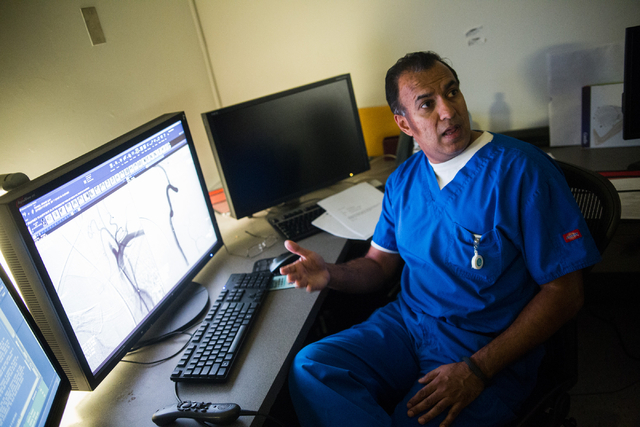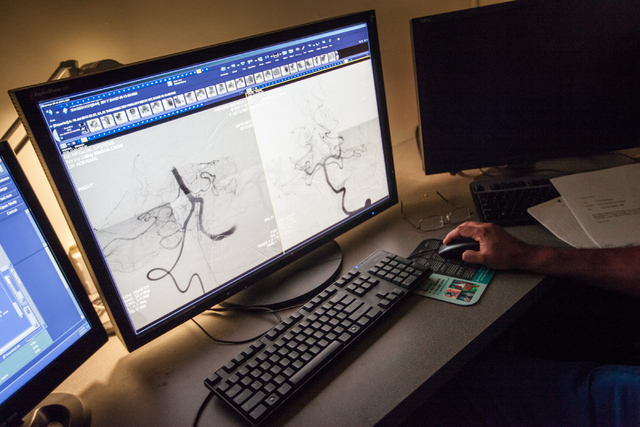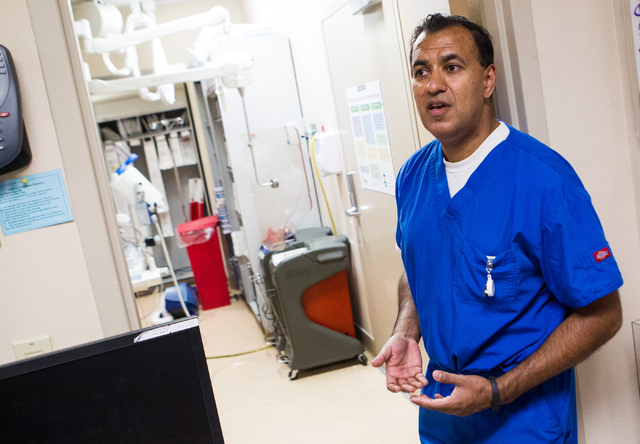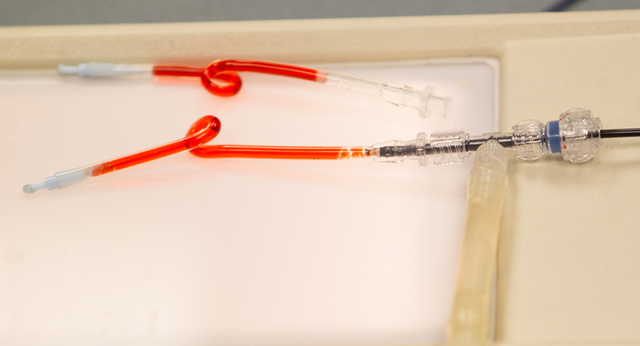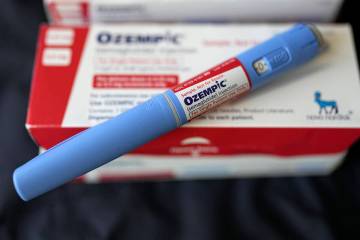Vacuum extracts blood clot that threatened to take tourist’s life
Miranda Wenske came to Las Vegas last summer to celebrate her birthday and wedding anniversary, not to try to kill herself.
But try she did, just as she’d unwittingly done for years.
She would have succeeded if it hadn’t been for Dr. Raj Agrawal, who knew how to use a vacuum cleaner.
That the near-death experience of the 30-year-old Texas belle is strange is beyond question.
It is also beyond question that her miraculous recovery from a blood clot thrown into her brain is another sign of how important technological advances are to medicine.
She suffers no ill effects from the stroke that had left her unable to breathe on her own.
The temperature hit 109 degrees on July 18, 2013, the first full day that Miranda and her husband, Nathan, spent in Las Vegas. Staying at Bellagio, they walked the Strip in the morning and then had lunch. Nathan then went back to his room and Miranda went off to explore another casino with a girlfriend who had also flown into town.
On that day Miranda did what she always did when she was awake — she indulged a nervous habit that she said relaxed her, cracking her neck several times an hour. She didn’t have to use her hands to bring about the reassuring pop, just twisted her head to the right.
Late in the afternoon, the mother of a little girl — the Wenskes left their 4-year-old daughter with relatives in Texas — became nauseated. Her left side became what she describes as “hypersensitive with a pins and needles feeling.”
What she didn’t know then — and wouldn’t find out for days from Agrawal — is that she was born with a weakness in the wall of her vertebral artery, which is in the neck and supplies blood to the brain. Years of neck cracking had probably injured the artery wall, forcing it to close up and spit out a blood clot that blocked blood flow to the brain.
“It’s still hard to believe,” Miranda drawled in a phone call from her home near Yoakum, Texas. “I’m so glad I was in Las Vegas when it happened. Our little hospitals around here couldn’t have handled it. It could’ve been really bad.”
Thinking she could handle her problem by cooling off, Miranda showered. When that didn’t help, Nathan called the Bellagio’s front desk. The hotel’s emergency medical services team checked her out for heat exhaustion and gave her a stroke test that she passed. But 20 minutes after the team left, she felt worse.
This time when Nathan called the front desk an ambulance was summoned. Soon Miranda was in Spring Valley Hospital’s emergency room. Again emergency personnel, whose tests still didn’t signal a stroke, thought she must be suffering ill effects from the heat.
But then, just as she was about to be released from the emergency room, her body shut down. She was frantically administered CPR. Then she was placed on a ventilator. She could no longer breathe for herself.
“I didn’t realize at first how serious it was,” Nathan Wenske said. “I thought maybe she was allergic to something they gave her. … When one of the nurses told me it was time to start calling other members of the family, I got it.”
A CT scan would show a clot had formed that blocked the flow of blood to critical parts of her brain. She was given the clot-busting drug tPA to attempt to dissolve the clot, but a second scan showed the clot had not fully dissolved.
It was time, Agrawal realized, to mobilize Spring Valley Hospital’s special procedures team and use what amounts to a tiny Penumbra Inc. vacuum the Valley Health System made available to him about two years ago.
The Penumbra system, the doctor says, reduces the risk of bleeding, and may be used up to eight hours after stroke symptoms appear. TPA must be used within three hours.
“Penumbra gives us another option when patients arrive at the hospital too late to receive tPA, or when the clot is too large for tPA to dissolve it completely,” Agrawal said.
Sitting recently before scans that showed the blood vessels inside Miranda’s body, Agrawal, an interventional neuroradiologist, pointed to the path followed by a catheter to get to the blood clot. Penumbra representative Kevin Dutcher showed how the vacuum attaches to a catheter.
“I take a small tube (catheter) from the femoral artery in the groin into the brain and place the catheter into the clot. Then we connect the catheter to a suction cannister. It is like a mini vacuum cleaner. You move the catheter back and forth just like a vacuum cleaner. It sucks the clot out into the cannister.”
In less than an hour, Agrawal had removed the blood clot; it came out in one piece. He also inserted a stent to ensure the weakened artery in Miranda’s neck stays open.
“What she suffered from is always fatal unless the clot is removed,” Agrawal said. “The reason this patient had complete recovery is because the ER physician recognized the problem fast, the stroke neurologist was consulted immediately and my special procedures team was activated right away. Time is critical as close to 9 million brain cells die every minute.”
While he’s also had good success using the device on other patients, the 46-year-old practitioner said that far too often patients don’t present in time for treatment.
“If the brain tissue is dead, there is no benefit of clot removal,” he said. “We were so fortunate that she actually happened to be in the hospital when the clot actually happened. She started feeling weird in the hotel and it was getting ready to go but didn’t happen until the hospital. I can’t stress enough how important time is with a stroke.”
Strokes, the third leading cause of death in the United States, kill about 160,000 Americans each year, the American Stroke Association reports. Strokes are also the leading cause of disability. Depending on the brain region affected, a stroke may cause paralysis, speech impairment and loss of memory and reasoning ability.
Agrawal said that what almost surely happened because of Miranda’s neck cracking should be a cautionary tale for everyone. Yes, he said, it’s true that she was born with an abnormality in an artery in her neck, but such behavior over a long period can be dangerous for anyone.
For years there has been a debate as to the risk of stroke because neck cracking by chiropractors. A 2012 study found: “Conclusive evidence is lacking for a strong association between neck manipulation and stroke, but is also absent for no association.”
Agrawal is not a fan of such procedures.
“It may be one in thousands of a chance,” Agrawal said, “but if you’re the one, I’m not sure you care about how small the risk is.”
Miranda, a construction company secretary, no longer cracks her neck. But she remembers what Agrawal said when he saw she’d recover completely.
“He said, ‘There’s my miracle,’ ” she recalled. “It’s nice to be a miracle.”
Contact reporter Paul Harasim at pharasim@reviewjournal.com or 702-387-2908.







